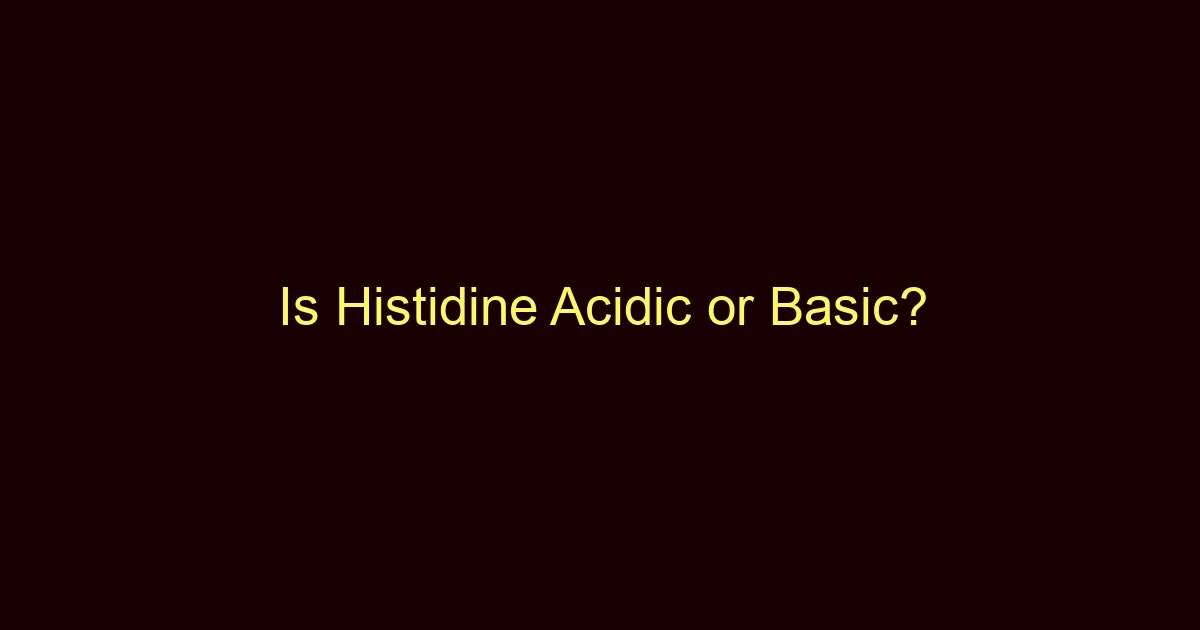Histidine is generally considered to be a basic amino acid due to the presence of an imidazole side chain that can accept a proton.
Histidine is one of the 20 amino acids that make up proteins and play an essential role in biological processes. Its unique chemical structure allows it to function in a versatile manner. A significant question that often arises is whether histidine is acidic or alkaline. Understanding the acidic or basic nature of histidine not only is crucial for biochemists but also offers insights into its role in enzyme catalysis, protein interactions, and other cellular functions. In this article, we’ll delve into the nuances of whether histidine is acidic or basic, looking at scientific evidence and explaining it in layman’s terms.
Is Histidine Acidic?
Direct Answer: No, histidine is not considered to be acidic.
In the realm of biochemistry, histidine is generally not classified as an acidic amino acid. Acidic amino acids, like glutamic or aspartic acid, have side chains that can donate a proton, acting as acids. Histidine has an imidazole side chain, generally accepting protons rather than donating them. You might think of acidic amino acids as the “givers” and basic amino acids like histidine as the “takers” when it comes to protons. Does that mean it can never act as an acid? Not necessarily. Histidine can occasionally act as an acid under specific conditions, but it’s the exception rather than the rule.
In the biochemical sense, the term “acidic” isn’t merely a black-and-white categorization. Think of it as a spectrum where certain conditions can tip the scale. However, under physiological pH, which is generally around 7.4, histidine acts more like a base. Simply put, if you’re trying to categorize it, you’d be more accurate calling histidine a basic amino acid than an acidic one.
Is Histidine Basic?
Direct Answer: Yes, histidine is considered to be a basic amino acid.
So what makes histidine basic? Let’s get into the nitty-gritty. The histidine side chain contains an imidazole ring with a nitrogen atom capable of accepting a proton. This is a quintessential characteristic of a base. In a cellular environment, this ability makes histidine incredibly versatile. It plays a vital role in enzyme catalysis and stabilizes protein structure interactions.
Ever tried balancing a pencil on your fingertip? Imagine histidine as that pencil; its basic nature helps it maintain balance when participating in biochemical reactions. Whether it’s in the active site of an enzyme or as part of a larger protein structure, the basic nature of histidine allows it to fit into diverse biochemical roles.
Histidine can act as both an acid and a base; however, it’s more inclined towards its basic properties, especially under physiological conditions. It’s like a Swiss Army knife in your biochemical toolbox, ready to step in and stabilize reactions or participate in catalysis when needed.
pH Values of Histidine:
Histidine typically has a pI (isoelectric point) around 7.6, indicating its basic nature. At this pH, it carries no net electrical charge. However, its side chain has a pKa value (acid dissociation constant) of about 6.0, which suggests that it can also act as a weak acid under certain conditions. While it’s not as basic as lysine or arginine, histidine still leans more toward the basic side of the spectrum than the acidic side.
Final Thoughts:
To sum it up, histidine is generally categorized as a basic amino acid due to its imidazole side chain that readily accepts protons. This feature makes it a critical player in various biological processes, from enzyme catalysis to protein stabilization. It’s like the multi-talented athlete in a sports team who can play offense and defense as needed but has a knack for scoring goals.
Although histidine can occasionally show acidic characteristics under specific conditions, it primarily acts as a base, especially under physiological conditions. Therefore, when posed with the question, “Is histidine acidic or basic?”, your most accurate answer would be that it’s a basic amino acid with a touch of versatility. So, the next time you encounter histidine in your biochemistry course or research, you’ll know exactly where it stands on the pH scale.

